Dealing with period cramps can be a real pain – literally! That’s why we are here to help. In this article, we’ll share 17 effective positions that can give you much-needed relief during those uncomfortable days of the month. Whether you are at work, seeking a restful night’s sleep or trying to stay active on the mat, these positions will keep your back (or should we say your stomach?). We will cover sitting positions, gentle stretches, sleeping positions, relaxation techniques and even some yoga postures.
What are Period Cramps ?
Let us now understand what period cramps actually are. Period cramps, medically called dysmenorrhoea, are caused by the contraction of the uterus during menstruation. The uterus contracts to expel its lining in order to expel menstrual blood. These contractions can cause varying degrees of discomfort, ranging from mild to severe.
Common symptoms of period cramps include abdominal pain, lower back pain and cramps in the pelvic region. It is important to know that everyone experiences period cramps differently. Some have only mild discomfort, while others may have more severe pain.
If you find that your period cramps are particularly severe, interfere with your daily activities, or are accompanied by unusual symptoms, be sure to see your healthcare provider. Your healthcare provider can evaluate your situation, advise you accordingly and rule out underlying conditions that may be contributing to your pain.
17 Essential Positions to Help Relieve Period Cramps
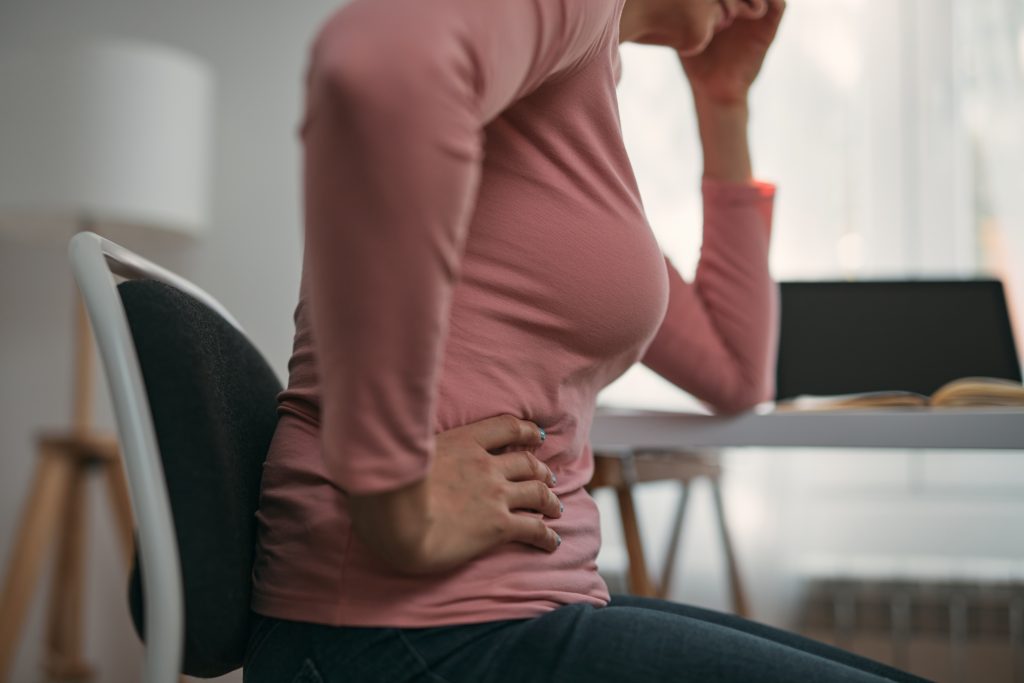
5 Easy Positions for the relief of period cramps at work
When you are at work, relieving period cramps is crucial to your productivity and overall well-being. Sitting positions and exercises can help alleviate discomfort and improve circulation so you can focus better and feel more comfortable during the workday. Here are some detailed explanations of the positions and exercises that can provide relief
1# Sitting positions to relieve discomfort and improve circulation
Ergonomic chair adjustments
Take a moment to assess your workspace and make sure your chair is properly adjusted. Make sure your chair is high enough so that your feet are flat on the floor. Sit in the chair with a straight back, relaxed shoulders and a comfortable hip position. Good posture promotes blood circulation and relieves pressure on your muscles, which can ease cramp-related discomfort.
2# Lean forward when sitting
If you feel pressure and discomfort in your abdomen, you can lean forward slightly to relieve this feeling. This position takes some pressure off the abdominal area and can provide temporary relief from cramps. When leaning forward, make sure you have good posture and keep your back straight and supported.
3# Gentle stretches and exercises to relieve pain
Performing seated torso twists Seated torso twists are effective for releasing tension in the lower back and abdomen. Start by sitting with your back straight and your feet flat on the floor. Gently turn your upper body to the right. While doing this, place your left hand on the outside of your right thigh and support yourself with your right hand behind you. Hold the stretch for a few seconds and feel the gentle stretch in your lower back and abdomen. Repeat the twist on your left side. These twists help to stretch and relax the muscles, which has a positive effect on cramps.
4# Try pelvic tilts
Pelvic tilts are beneficial to tighten and relax the pelvic muscles, which can help relieve cramps. While sitting, begin by tilting your pelvis forward allowing your lower back to arch slightly. Hold this position for a few seconds then tilt your pelvis backward, rounding your lower back. Repeat these pelvic tilts a few times, focusing on the movement and stretching of your lower abdomen. This exercise helps to improve circulation to the pelvic area and reduce tension and discomfort.
5# Stretch your neck and shoulders
Period cramps can cause muscle tension and tightness in the neck and shoulder area. To relieve this tension, incorporate stretching exercises for your neck and shoulders into your routine. Start by gently tilting your head to the side and bringing your ear closer to your shoulder. Hold the stretch for a few seconds, feeling the gentle stretch along the side of your neck. Repeat this on the other side. Also, roll your shoulders back and forward and allow the movement to loosen the muscles in your shoulders. These stretches can help relieve muscle tension, which can indirectly relieve the discomfort associated with period cramps.
Remember that everyone’s experience of period cramps is different. It is important to listen to your body and find the positions and exercises that work best for you. If a position or exercise causes discomfort or makes your symptoms worse, you should stop the exercise and see a doctor for individual advice.
3 Comfort Positions to Relieve Period Cramps in Bed
If you are trying to get a good night’s sleep while struggling with menstrual cramps, finding a comfortable position can make a big difference to your overall well-being. Here are some positions and relaxation techniques that can help relieve cramps and promote better sleep
Sleep positions for optimal comfort
1# Lie on your side with a pillow between your legs

One of the most comfortable sleeping positions for relieving period cramps is lying on your side with a pillow placed between your legs. This position helps relieve pressure on the lower abdomen as well as aligns your spine and pelvis. By supporting your legs with a pillow, you can reduce strain on your lower back and promote better blood circulation, which can relieve cramp-related discomfort.
2# Adopt the fetal position
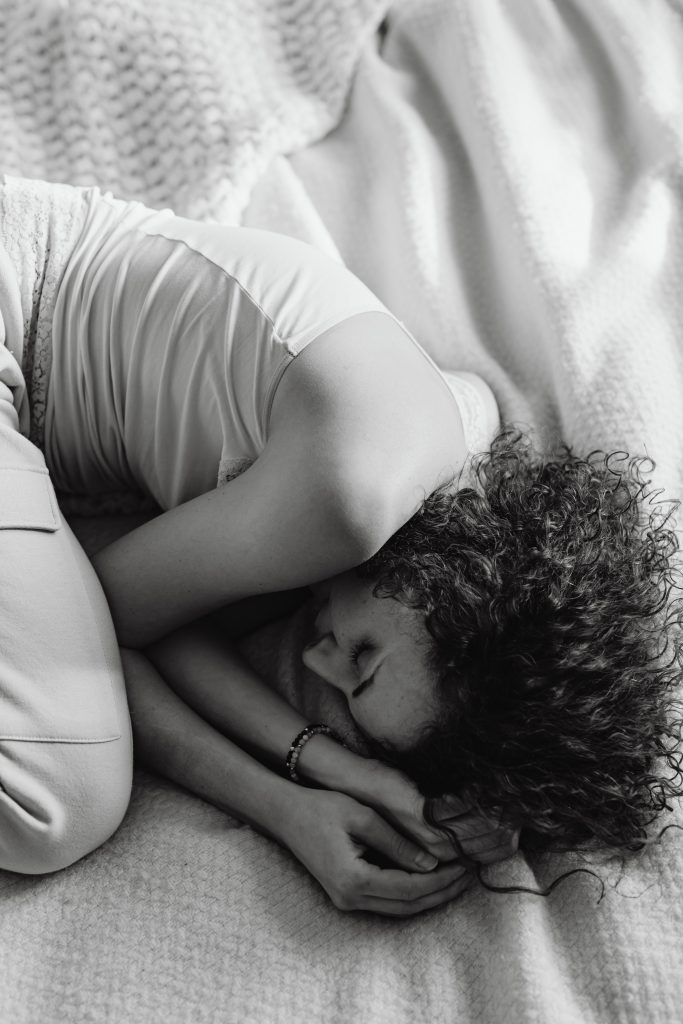
The fetal position is another sleeping position that can provide relief from menstrual cramps. Curl up on your side, bringing your knees towards your chest and tuck your chin slightly. This position helps to relax the muscles in the abdomen and lower back, reducing the intensity of the cramps and promoting a sense of relaxation.
3# Opt for a semi-reclined position with pillows for support
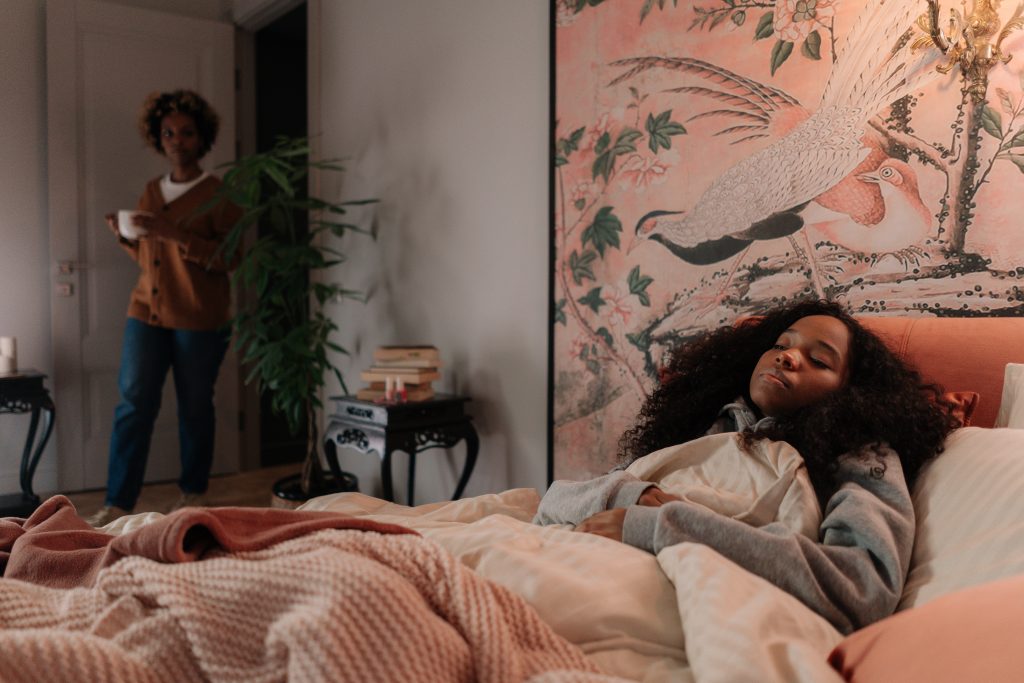
If you are uncomfortable lying flat on your back or side, you can adopt a semi-reclined position. Support yourself with pillows to create a slight incline. This position helps to relieve discomfort by reducing pressure on the abdomen and providing additional support for your back. Adjust the number and placement of pillows to your comfort and make sure your upper body is comfortably elevated.
Relaxation techniques to ease cramps
Practise deep breathing exercises
Deep breathing exercises are an effective relaxation technique to calm the body and relieve pain. Lie on your back or in a comfortable position, place a hand on your stomach and breathe slowly and deeply. Breathe in deeply and feel your abdomen rise and breathe out slowly and feel your abdomen lower. By focusing on your breath and allowing it to deepen and slow down, you can relieve stress and tension, relax and ease cramps.
Do meditation or guided imagery
Meditation and guided imagery are practises that can help to relax and relieve cramps. Find a quiet and comfortable place in bed, close your eyes and focus on calming and soothing images. You can imagine a peaceful natural setting, such as a beach or a forest, or imagine your muscles gradually relaxing and the pain subsiding. These practises help to divert your attention from the discomfort, relieve stress and create a sense of calm that can ease the cramps.
Use heat therapy with a hot water bottle or heating pad
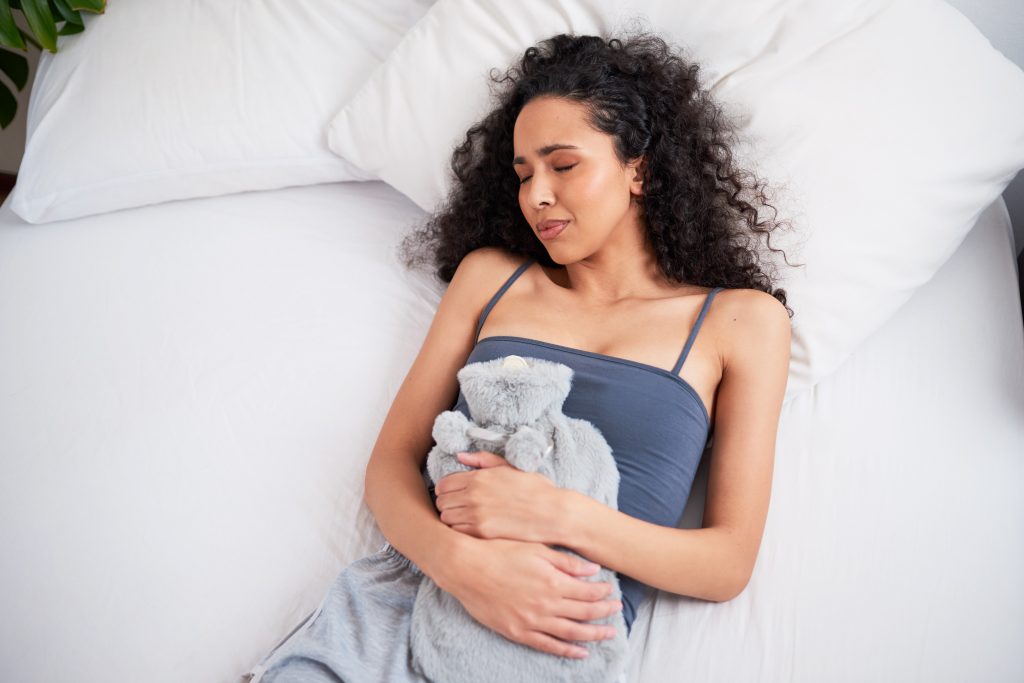
Heat therapy is a proven method for relieving cramps. Place a hot water bottle or heating pad on your lower abdomen or lower back for about 15-20 minutes. The heat helps to relax the muscles, increases blood flow to the area and can significantly relieve the discomfort of cramps. Be sure to place a cover or towel between the heat source and your skin to avoid burning and set the temperature to a comfortable level.
Also Check – Yoga for Period Relief – 8 Poses to Relieve Menstrual Cramps, Pain, and Irregularity
9 Gentle Yoga Postures and Gentle Stretches to relieve menstrual cramps on the mat
When you are on the mat, certain yoga postures and gentle stretches can provide relief from period cramps. By incorporating these postures into your practise, you can relieve discomfort and promote relaxation. Here are some detailed explanations of the positions mentioned
1# Supported Savasana (supine position)
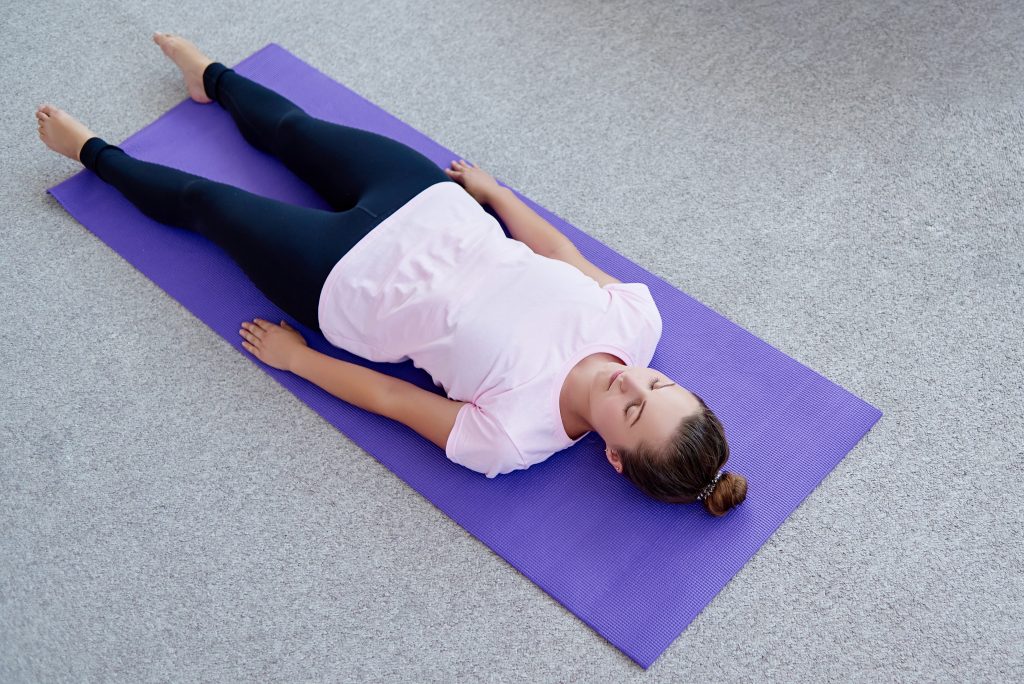
Instructions
- Lie on your back on the mat.
- Place a bolster or folded blanket under your head and neck, providing support.
- Allow your arms to relax by your sides, palms facing up.
Breathing
- Breathe naturally and deeply, focusing on releasing tension with each exhalation.
Benefits
- Promotes deep relaxation and a sense of calm.
- Allows your body to fully relax, reducing tension in the lower abdomen.
- Soothes and alleviates period cramps.
- Encourages a state of deep relaxation and rejuvenation.
2# Cobra pose (Bhujangasana)
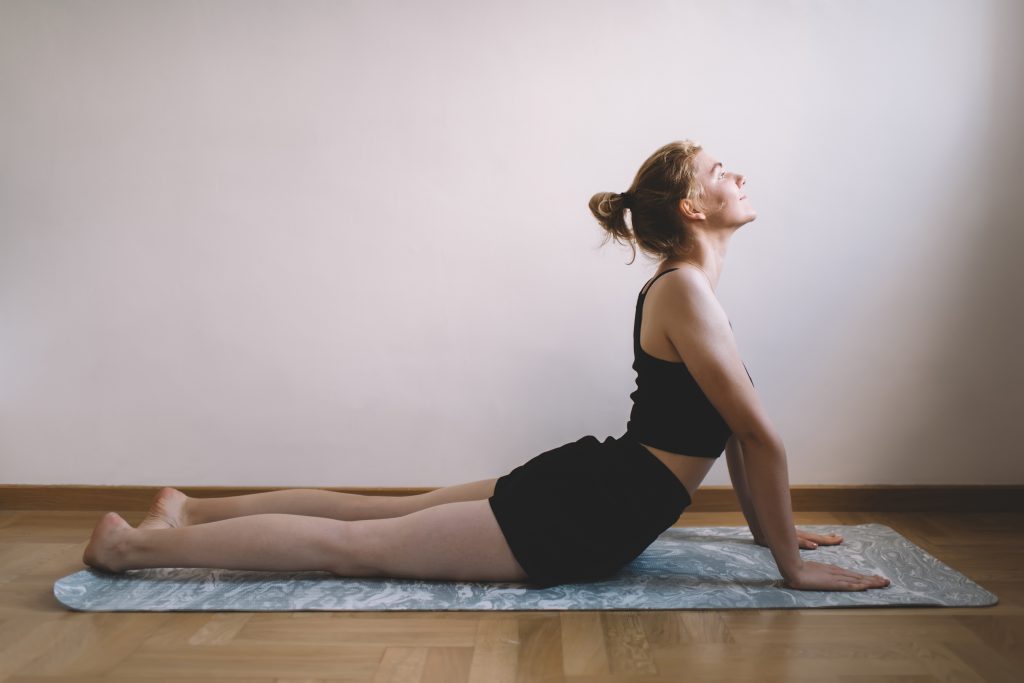
Instructions
- Start by lying on your stomach with your legs extended and the tops of your feet pressing into the mat.
- Place your palms on the mat near your chest, fingers spread wide.
- Inhale and gently lift your upper body, using your arms, while keeping your pelvis grounded.
- Keep your elbows close to your sides and shoulders away from your ears.
Breathing
- Inhale as you lift your chest, expanding the front of your body.
- Exhale as you lower back down to the mat.
Benefits
- Stretches and strengthens the abdominal muscles.
- Opens up the chest, improving lung capacity and promoting deep breathing.
- Helps relieve cramp discomfort.
- Improves posture and spinal flexibility.
3# Fish pose (Matsyasana)
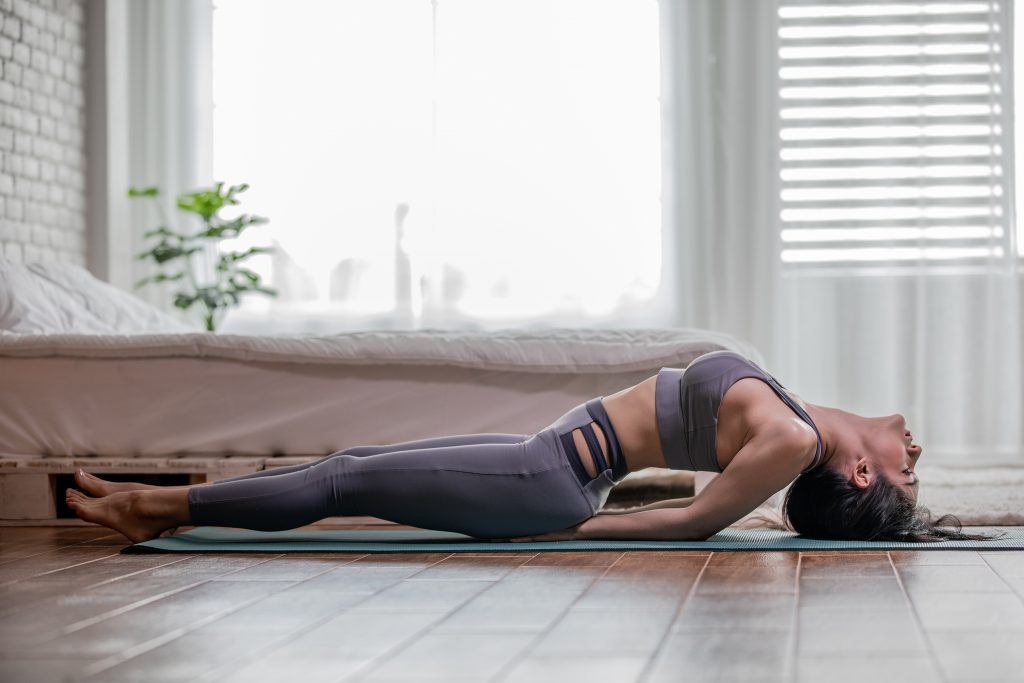
Instructions
- Begin by lying on your back with your legs extended.
- Place your hands underneath your hips, palms facing down.
- Pressing into your forearms, lift your chest and arch your upper back, tilting your head back.
- Allow the crown of your head to rest lightly on the mat, if possible.
Breathing
- Breathe deeply, expanding your chest and upper back as you inhale.
- Exhale fully, relaxing into the pose.
Benefits
- Stretches the front of the body, including the abdomen.
- Opens up the chest and throat, improving posture and breathing.
- Relieves tension and discomfort associated with cramps.
- Stimulates the thyroid and parathyroid glands, promoting hormonal balance.
4# Cat-Cow stretch
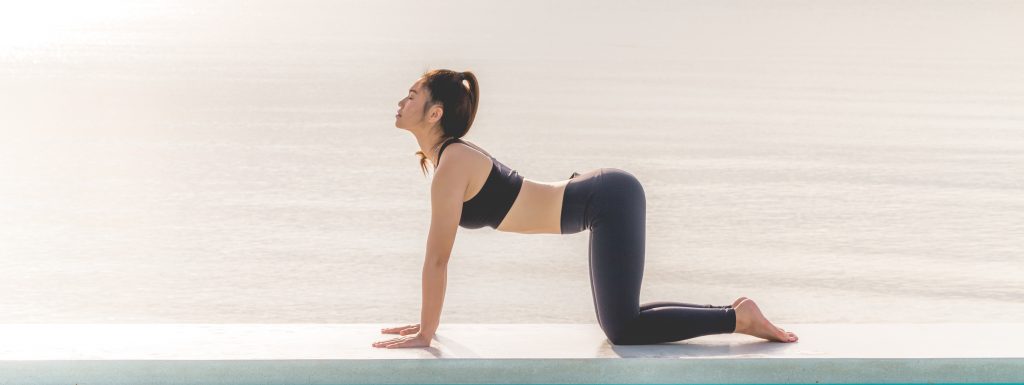
Instructions
- Start on all fours with your hands beneath your shoulders and knees below your hips.
- Inhale as you drop your belly towards the mat, lifting your head and tailbone (Cow pose).
- Exhale as you round your spine towards the ceiling, tucking your chin to your chest (Cat pose).
- Repeat this sequence for several rounds, synchronising your breath with the movements.
Breathing
- Inhale as you move into the Cow pose, expanding your belly and chest.
- Exhale as you move into Cat pose, rounding your back and releasing tension.
Benefits
- Alleviates cramps and releases tension in the lower back.
- Improves spinal flexibility and posture.
- Stimulates digestion and promotes a healthy digestive system.
- Helps relieve stress and promote a sense of relaxation.
5# Bridge pose (Setu Bandhasana)
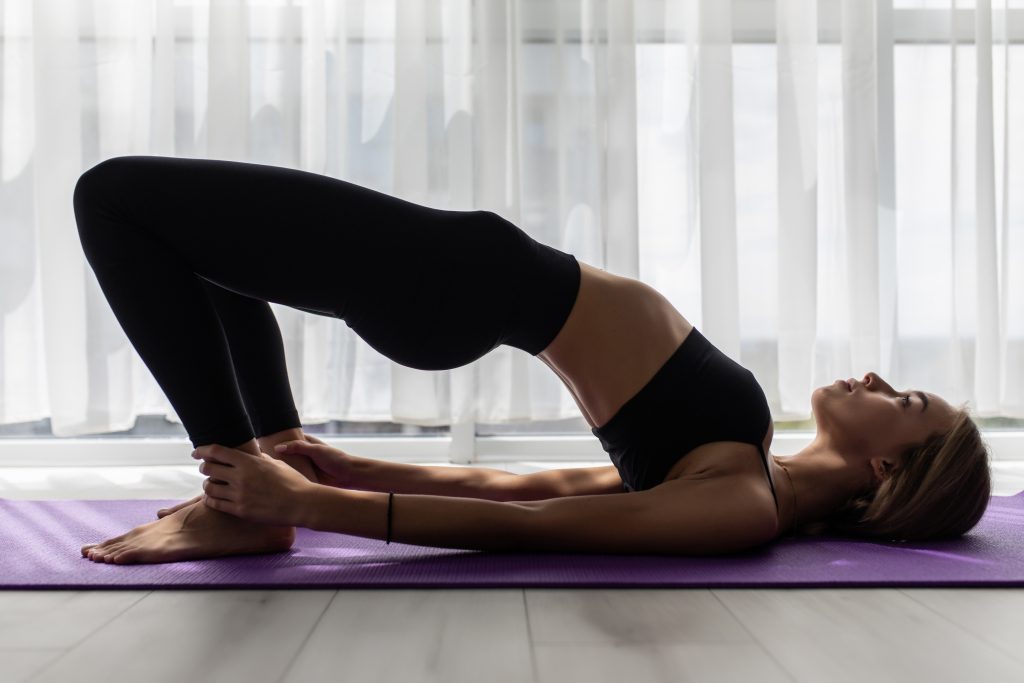
Instructions
- Lie on your back with your knees bent and feet flat on the mat, hip-width apart.
- Place your arms alongside your body with your palms facing down.
- Press your feet into the mat as you lift your hips off the ground, creating a bridge shape with your body.
- Optional: Interlace your hands beneath your hips for additional support.
Breathing
- Inhale deeply as you prepare for the pose.
- Exhale as you lift your hips and hold the position.
- Breathe deeply and rhythmically throughout the pose, keeping your breath steady.
Benefits
- Strengthens the pelvic floor muscles, which can help alleviate cramp discomfort.
- Stretches and opens the chest, shoulders and neck.
- Engages the glutes, hamstrings and lower back muscles.
- Improves spinal flexibility and posture.
- Enhances circulation and energises the body.
6# Child’s pose (Balasana)
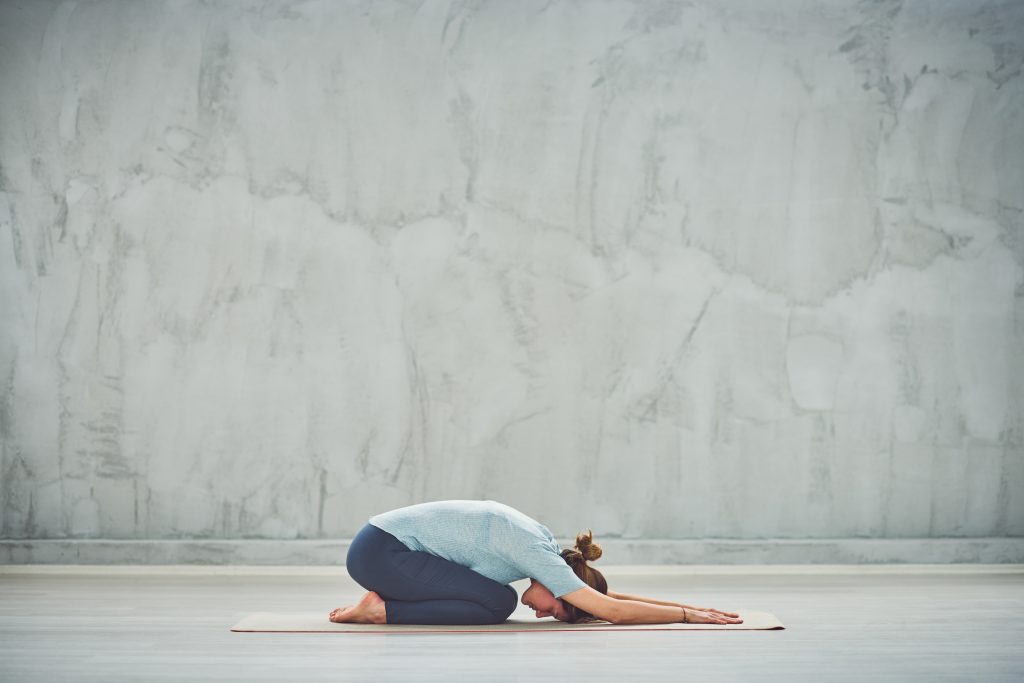
Instructions
- Begin by kneeling on the mat with your big toes touching and your knees hip-width apart.
- Sit back on your heels and lower your torso down, allowing your forehead to rest on the mat.
- Extend your arms forward, placing your palms or fingertips on the mat.
- Modify the pose by widening your knees if needed or placing a bolster or folded blanket between your thighs for support.
Breathing
- Take slow, deep breaths as you settle into the pose.
- Inhale as you expand your back body.
- Exhale as you release tension and surrender into the stretch.
Benefits
- Gently stretches the lower back, hips and thighs.
- Relaxes the pelvic area, promoting relief from cramps.
- Calms the mind and promotes a sense of surrender and relaxation.
- Releases tension in the upper body and shoulders.
- Can help relieve stress and anxiety.
7# Roll downs (Pilates)
Instructions
- Sit on the mat with your legs extended in front of you, feet flexed and heels on the ground.
- Lengthen your spine and engage your core.
- Slowly roll your spine down, one vertebra at a time, until you’re lying flat on your back.
- To roll back up, engage your core and initiate the movement from the lower abdominals, stacking each vertebra back up to a seated position.
Breathing
- Inhale to prepare for the movement.
- Exhale as you roll down, focusing on articulating each vertebra.
- Inhale at the bottom position.
- Exhale as you engage your core to initiate the roll back up.
Benefits
- Releases tension in the lower back and abdominal muscles.
- Promotes relaxation and reduces cramp discomfort.
- Strengthens the core and improves core stability.
- Increases body awareness and control.
- Enhances spinal mobility and flexibility.
8# Butterfly pose (Baddha Konasana)

Instructions
- Sit on the mat with your legs extended in front of you.
- Bend your knees and bring the soles of your feet together, allowing your knees to fall out to the sides.
- Gently press your elbows into your thighs to deepen the stretch.
- Lengthen your spine and sit up tall.
Breathing
- Take slow, deep breaths, inhaling and exhaling through your nose.
- Allow your breath to deepen with each inhalation and soften with each exhalation.
Benefits
- Opens up the hips and stretches the inner thighs.
- Promotes blood circulation to the pelvic area, providing relief from cramps.
- Releases tension in the groin and hip muscles.
- Stimulates the abdominal organs, aiding digestion and relieving bloating.
- Can help improve posture and spinal alignment.
9# Pigeon pose (Eka Pada Rajakapotasana)
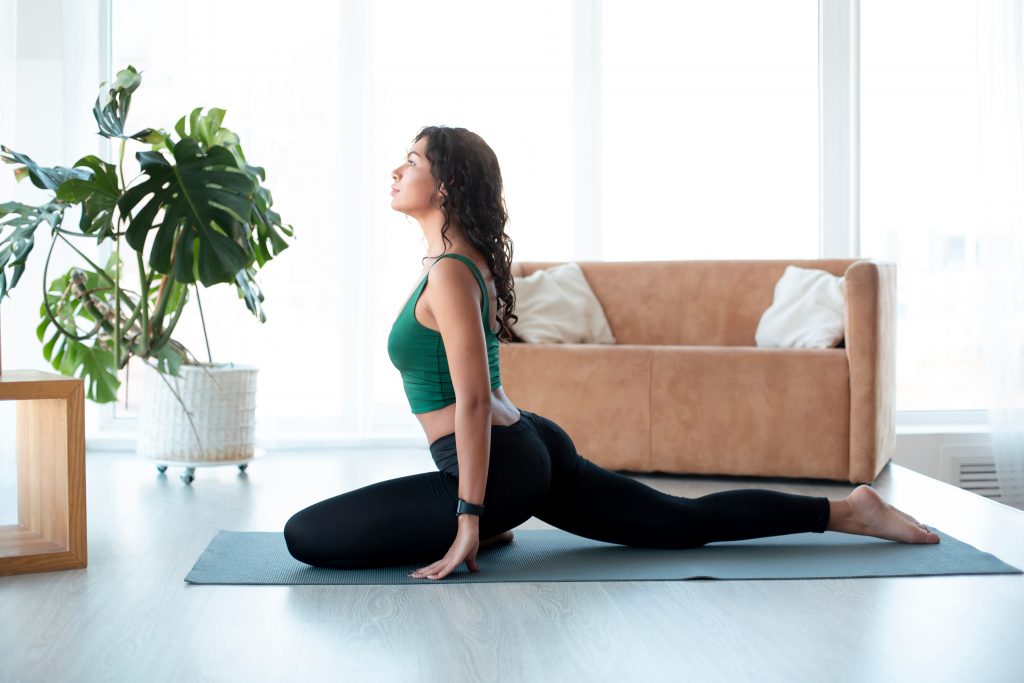
Instructions
- Begin in a low lunge position with one knee bent in front and the other leg extended straight behind you.
- Slowly slide the front leg forward, so that the shin and foot are parallel to the front of the mat.
- Adjust your back leg as needed, keeping it straight or slightly bent for stability.
- Square your hips to the front of the mat and lower your upper body down, resting on your hands or forearms.
Breathing
- Breathe deeply and evenly, allowing your breath to flow naturally.
- With each exhale, soften into the stretch and release tension in the hips.
Benefits
- Deeply stretches the hips, particularly the piriformis muscle.
- Alleviates tension and tightness in the hips and glutes.
- Improves hip mobility and flexibility.
- Stimulates blood flow to the pelvic area, reducing cramp discomfort.
- Releases stored emotional and physical tension.
Remember to practise these poses mindfully, respecting your body’s limits and adjusting the poses as needed. Each person’s experience may vary, so listen to your body and honour what feels right for you. If you have any pre-existing injuries or medical conditions, it’s advisable to consult with a healthcare professional or a certified yoga instructor before attempting these poses.
Also Check – 10 Effective Home Remedies to Stop Prolonged Periods
Additional Tips for Managing Period Cramps
Maintain a balanced diet and stay hydrated to support overall well-being.
- Eat a nutritious diet that includes a variety of fruits, vegetables, whole grains and lean proteins.
- Include foods rich in essential nutrients such as calcium, magnesium and vitamin B6, which can help reduce menstrual cramps.
- Stay hydrated by drinking an adequate amount of water throughout the day to support healthy bodily functions and reduce bloating.
Regular exercise and physical activity can help alleviate cramps and improve mood.
- Engage in moderate aerobic exercises such as brisk walking, cycling, or swimming to increase blood circulation and reduce cramp intensity.
- Consider incorporating gentle exercises like yoga or Pilates, which can stretch and strengthen the muscles, improve flexibility and promote relaxation.
- Find an exercise routine that suits your preferences and aim for at least 30 minutes of activity most days of the week.
Consider using pain relief options such as over-the-counter medications or natural remedies.
- Over-the-counter pain relievers such as ibuprofen or naproxen sodium can help alleviate menstrual cramp pain. Always follow the recommended dosage and consult with a healthcare professional if you have any concerns.
- Explore natural remedies like applying a heating pad or taking warm baths to relax the muscles and reduce discomfort.
- Herbal teas such as chamomile, ginger, or peppermint may also have soothing effects on cramps.
Practice self-care and listen to your body’s needs during your menstrual cycle.
- Prioritise self-care activities that promote relaxation, such as taking warm baths, practising mindfulness, or engaging in hobbies you enjoy.
- Allow yourself sufficient rest and sleep during your period to support your body’s natural healing processes.
- Practice stress management techniques like deep breathing, meditation, or gentle stretching to reduce stress levels, which can contribute to cramp severity.
- Be attentive to your body’s signals and adjust your daily routine or activities as needed to accommodate any discomfort or fatigue.
Incorporating these 17 essential positions into your routine can help relieve period (menstrual )cramps and increase your well-being. Remember to experiment with different positions and techniques to find out what works best for your individual needs. If you experience severe or persistent pain, do not hesitate to consult a doctor. Take care of yourself and prioritise your health and well-being during menstruation.
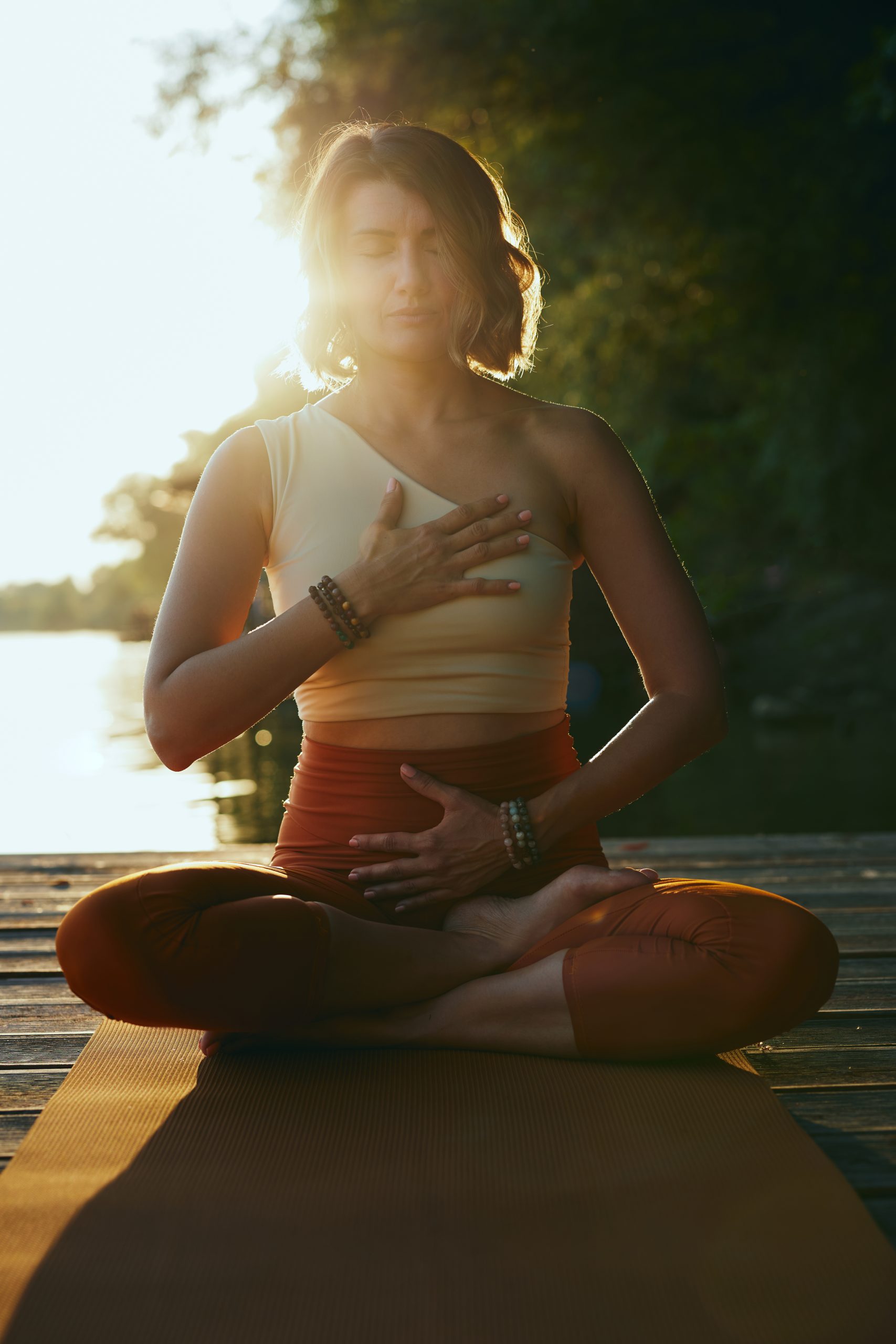
Leave a Reply